|
A brief history of the location
|
|
|
|
Discovered in 1909 by the Rondon Commission, it was first named Rio da Dúvida or River of Doubt (the origin of the name deriving from the fact that the path of the river’s outlet was unknown). In 1913 a scientific expedition was undertaken. The American president Theodore Roosevelt took part in the mission that lasted until May of 1914, when Rondon named this 1,409 km river in the president’s honor, dubbing it the Rio Roosevelt. Among its various activities, the expedition was involved in the collection of animals and plants for the American Museum of Natural History.
|
|
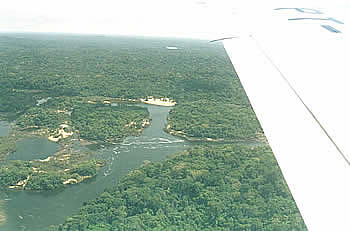
|
|
|

|
|
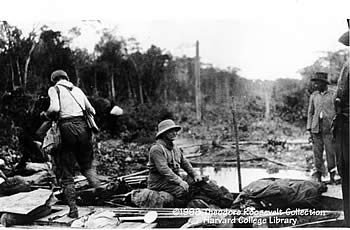
|
|
|
|
The river’s source begins on the Parecis plain in Vilhena, in the State of Rond&oecirc;nia, at a latitude of 13º19’, its course running southeast to north, extending to the Rio Madeira, a tributary feeding into its right border at latitude 5º S. The Rio Roosevelt, at its upper regions is still known as the Rio da Dúvida, Rio Castanho along the middle of its length and Aripuanã at its lower reaches. Its course traverses a path through the states of Rond&oecirc;nia, Mato Grosso and Amazonas, fed by the waters of various tributaries, among which are the Rios Capitão Cardoso and Tenente Lira, entering from its left margin, originating in Vilhena (Parecis) and the Rios Madeirinha and Branco joining it on its right margin.
This scientific expedition was the basis for the book “Through the Brazilian Wilderness” written by the North American president, in which various accounts of the region are detailed.
|
|
|
|
In one of the book’s passages the author refers to a waterfall which at the time was called Cahoeira Santa Rita that came to be known as Cachoeira do Inferno (Hell’s Waterfall). It was impossible to cross. On April 21, 1914, the American ex-president traveled along trails where the Rio Roosevelt Lodge is currently located and after more than 90 years, the region remains exactly as it was at the time of Roosevelt’s passage.
|
|
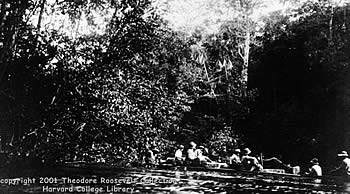
|
|
|

|
|
I mention this, because our destination is at this very section of the river.
|
|
|
|
Through an invitation extended by High Hooks Fishing Tours, I had the opportunity to conduct a fly fishing course exclusively for the lodge’s fishing guides.
In addition, I was to be accompanied by two Americans – Mark and Philip – members of IGFA – fishing together with a friend Ian Sulocki, of High Hook Fishing Tours.
|
|
|

|
|

|
|
|
|
The Rio Roosevelt Lodge is located in the State of Amazonas near the borders of the States of Mato Grosso and Rond&oecirc;nia, at the foot of the Cachoeira do Inferno.
|
|
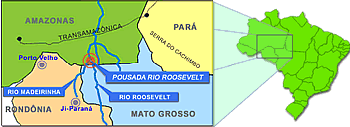
|
|
|
|
The best route for reaching the lodge is via regularly scheduled flights to city of Porto Velho in Rond&oecirc;nia and from there by chartered flight to the lodge. There are no roads to the lodge, making it accessible either by plane or boat. Passage over water makes for an almost interminable voyage, with access to the river via a bridge on the Transamazon Highway, a distance of 18 hours to reach the lodge. The flight from Porto Velho to the lodge averages an hour and 30 minutes.
|
|
|

|
|
The landing strip at the lodge is 980 meters long by 60 meters wide. Constructed of well compacted gravel, it was built to handle aircraft like Grand-Caravans, King-Airs, Senecas, among others. The lodge operates throughout 12 months of the year.
During the week I was there, I divided my time between providing fly fishing instruction and fishing, as not all the guides were available to me at the same time - some of them being occupied with the American guests.
|
|
|
|
Some tips about fishing in the region
|
|
|
|
Due to the positioning of the waterfall, fishing takes place above and below it. Below the waterfall there are a diversity of locations where one can fish for tucunaré (peacock bass), in small bays and sheltered areas with slow running water. On the river’s bed it’s possible to catch fish next to submerged structures like branches, tree trunks, or hill-like rocks.
|
|

|
|
|

|
|
On the lower portion of the river, at it was necessary to leave the boats to be able to continue the navigation, allowing the guides to portage them below the strong rapids.
|
|
|

|
|

|
|
|
|
Shortly after the Cachoeira do Inferninho there is an excellent area to fish for matrinxãs.. Schools of them are easily visible, but catching them demands very precise casting. Along many points of this dissent the fisherman will have only a single chance to make a cast at their chosen target. Pacú Bandeira and Pacú Branco are common as well in this location, able to be caught with flies imitating a red fruit (a species of araçá or wild guava).
|
|

|
|
|
|
Our fishing on the lower portion of the river took place over two days. On the first day we fished up to the Cachoeira do Inferninho. On the second day our objective was to descend the waterfall, reaching an advance encampment of the lodge, two hours distant from the waterfall, where we were to have lunch, returning to the lodge in the late afternoon.
|
|
|

|
|

|
|
|

|
|
Along this segment of the Roosevelt the river alternates between long stretches of calm, deep water, followed by sections of rapid and shallow waters. Throughout the river’s length, we frequently caught tucunaré, bicuda and payara.
In the portion of the river above the Cachoeira do Inferno, one can fish on two distinct rivers - on the Roosevelt itself, or on the Madeirinha, one of its tributaries.
|
|
|
|
On the portion of the river above the waterfall, we spent two days fishing the Roosevelt and two days on the Madeirinha, with more productive peacock bass capture results.
|
|

|
|
|

|
|
They are completely distinct rivers - the Roosevelt with darker water (almost the color of Coca-Cola), extremely clean, with vast rocky areas. A few white sand beaches provide a visual contrast to the color of the river, as well as great locations for fishing for peacocks and bicuda.
|
|
|
|
A large part of the river is covered with a rocky bottom, very shallow and difficult to navigate at first light and at dusk, at just which times the guides of the lodge cross these stretches with great agility and almost zero visibility, something which the uninitiated angler would be hard pressed to accomplish.
|
|

|
|
|

|
|
&It’s a river with few bays or lakes, some of which are quite far from the lodge, requiring some hours to reach and therefore demanding early morning departure.
Normally fishing just takes place in the main river channel itself, at select points like exits of streams, at rocks in mid-river, near large sloping walls of stone, or along the banks, where fish pass to leave the river’s current.
|
|
|
|
Some areas of still water, created by rocks are excellent places from which cast flies as well.
While on the Madeirinha, the fishing is a bit different.
|
|

|
|
|
|
Being a river with a sandy bottom, and much shallower, the peacocks tend not to spread out. When you come upon a fish, you can be certain that there will be many others in the vicinity. This river has a number of lakes quite close to the lodge, that make peacock bass fishing a lot easier, principally for those unaccustomed to fish for them, as was the case with the Americans.
|
|
|

|
|
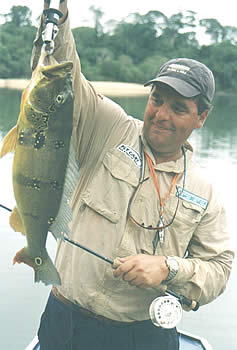
|
|
|

|
|
The lodge maintains two encampments (advance bases) on both rivers (each about 3 hours distant from the lodge by boat), where the angler can remain overnight and continue fishing on the upper river the following day.
|
|
|

|
|

|
|
|
|
For the fisherman who gets to know the region, there are some great fishing opportunities here, with a good variety of species to be caught, as accessible with flies, as with artificial lures used by bait casters – or night fishing for catfish or croaker.
|
|
|
|
About the fish
|
|
|
|
There are two species of peacock bass present in the region, the tucunaré borboleta (butterfly peacock bass) – or as the locals refer Açú, (not to be confused with Açú found on the Rio Negro) and the tucunaré pitanga, slightly smaller, but with much more brilliant coloration.
|
|

|
|
|

|
|

|
|
|

|
|
Payara and bicuda are to be found in all locations. At the foot of the Cachoeira do Inferno one can find larger payara and some big bicuda as well. Fishing in this location is best at the end of the day, in the final hour of sunlight.
|
|
|

|
|

|
|
|
|
For those who want to fish for leather skinned catfish at night, there are various extremely deep locations that are excellent spots for pirarara (redtail catfish), filhote (the “fry” of the piraíba catfish, weighing up to 60 kg), jaú, jundiá and cachara or surubim. Not to mention corvina (croaker) fishing as well.
In addition to these species, matrinxã, pacú bandeira and pacú branco are good choices, primarily to test the aptitude of any fly fisherman. Caranha is yet another species to be found here. You’ll see some matrinxã in the range of 3 kilos that simply ignore any bait presented to them. Only the small ones, weighing about a half kilo, will risk attacking the flies.
|
|
|

|
|

|
|
|
|
There is the possibility to fish for the rarely encountered jatuarana, which can reach a weight of 5 or 6 kilos and can be found in the region of the Madeirinha, around 5 hours by boat from the lodge. But our knowledge of this fish was only by word-of-mouth, having been promised that on our next trip to the lodge that we would attempt to find this fish.
|
|

|
|
|

|
|
As one can see, the region offers a rich variety of sport fishing species. Not to mention the small fish like jacundá and sardinha, or the plentiful lambari that can be fished with very light gear.
|
|
|
|
Some information about the lodge and services
|
|
|
|
Arriving at the Rio Roosevelt Lodge, you’ll be astonished with the location.
|
|

|
|
|

|
|
The cottages (of which there are 6) possess all of the necessary comforts (i.e., like air-conditioning, minibar and private baths equipped with hot water) - while nicely integrating the fisherman or eco-tourist into the environment of the Amazon rainforest.
|
|
|
|
In addition, there is a laundry service and two ice machines capable of generating 400 kg of ice per day.
The lodge contains a climate controlled restaurant with a panoramic view of a natural beach from which you can refresh yourself in the waters of the Rio Roosevelt.
The daily fare includes breakfast, lunch, a happy hour and dinner, with beer, soft drinks, freshly prepared fruit juices and mineral water included.
|
|

|
|
|

|
|
Communication with the lodge is maintained via radio with its office located in Porto Velho.
For fishing, the lodge provides 6 meter boats, equipped with 25 hp outboard motors and swivel chairs. The boats will soon be equipped with electric motors according the lodge’s staff.
|
|
|
|
In addition, the lodge has an advance base located on the Rio Roosevelt below the Cachoeira do Inferninho (a distance of 3 hours by boat), that provides support for those fisherman who wish to take advantage of an optional overnight remote encampment. Two additional advance bases are being constructed, one on the Rio Madeirinha and the other on the Roosevelt, above the Cachoeira do Inferno.
|
|

|
|
|
|
The lodge has also constructed an observation tower for birdwatchers, that provides an overall view of the region, plus ecological trails in the middle of the Amazon forest.
Even nature collaborates with the beauty of the location. Thousands of butterflies can be seen in every location one walks or boats. Had the river had been called “River of Butterflies”, this would have been an equally suitable name.
|
|
|

|
|

|

|
|

|
|
|
|
Wild animals like the capybara and mutum (Red-billed Curassow), are always in close proximity to the restaurant and cottages, creating a welcoming setting.
|
|
|

|
|

|

|
|

|
|
|
|
About the course for guides
|
|
|
|
Fly Cast, in its mission to disseminate information about fly fishing throughout Brazil, conducted yet another course exclusively for the fishing guides of the lodge.
With the objective of orienting these sport fishing tourism professionals, so that they might better serve the fly fisherman, they were instructed in various concepts and approaches to the multiple aspects associated with the subject.
|
|
|

|
|
The Rio Roosevelt Lodge fishing guides received practical training, with exercises in casting, plus instruction in adapting the concepts of fly fishing to the conditions of the region. In the end, they were prepared to welcome the fly fisherman safely and with the appropriate know-how.
At the completion of training, the Rio Roosevelt Lodge was equipped to receive and meet the needs of the more demanding fly fishing public – further differentiating itself among Brazilian fishing lodges.
|
|
|
|
This initiative to qualify guides in the practice of fly fishing is almost unheard of in Brazil. This past September we conducted the first such course exclusively for the guides of Xingú River Lodge (another High Hook Fishing Tours property), in the State of Pará, qualifying its guides. As a result the guides of the Rio Roosevelt and Xingu River Lodges have been certified in fly fishing techniques by the Fly Cast school.
|
|

|
|
|
|
This course was held over 3 days – during the evening hours of which we conducted lectures and discussions on theory – while during the mornings we provided practical training).
|
|
|

|
|

|
|
|

|
|
Topics like reading the water, safety procedures, judging distance, approaching a fishing location, positioning and handling of boats were broadly discussed. Selecting and working with flies, assembling equipment and tying leaders, were also subjects covered in the lectures. In the practical portion of the course, guides received training in casting (this provided more for the purpose of orientation, as they do not fish with their clients), solidifying their understanding of the theory. An outing by boat, demonstrating the most promising fly fishing locations, ideal distances for casting, working with flies and how they function in practice, among other subjects, provided the guides with a thorough understanding of the theory and practice of fly fishing – enabling them to satisfactorily meet the needs of the fly fisherman.
|
|
|

|
|

|
|
|
|
In addition to these specific topics, other topics were covered by Ian Sulocki, one of the principals of High Hook Fishing Tours and a consultant to PNDPA (the Brazilian Sport Fishing Association) regarding the general subject of sport fishing.
|

























































